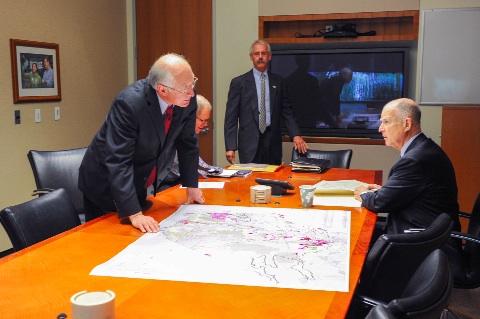DOI approves 1.1 GWs of renewable projects in Southwest
 Earlier this week, and perhaps as his last salvo in office before retiring as Secretary of the Interior Ken Salazar, announced approval of three new giant renewable energy projects, the McCoy Solar Energy Project, the Desert Harvest Solar Farm and the Searchlight Wind Energy Project. Secretary Salazar announced he was retiring in his position as Interior Secretary and though she has not been confirmed, Sally Jewell—currently outdoor sporting goods giant REI’s CEO, was nominated as his replacement.
Earlier this week, and perhaps as his last salvo in office before retiring as Secretary of the Interior Ken Salazar, announced approval of three new giant renewable energy projects, the McCoy Solar Energy Project, the Desert Harvest Solar Farm and the Searchlight Wind Energy Project. Secretary Salazar announced he was retiring in his position as Interior Secretary and though she has not been confirmed, Sally Jewell—currently outdoor sporting goods giant REI’s CEO, was nominated as his replacement.
“These renewable energy projects reflect the Obama Administration's commitment to expand domestic energy production on our public lands and diversify our nation's energy portfolio,” Secretary Salazar said. “In just over four years, we have advanced 37 wind, solar and geothermal projects on our public lands—or enough to power more than 3.8 million American homes. These projects are bolstering rural economies by generating good jobs and reliable power and strengthening our national energy security,” he said.
Both solar projects are in California and consist of 900 megawatts. The 750 megawatt McCoy solar project was the largest project approved in this round and is one of the largest approved solar projects. The Desert Harvest project, at 150 megawatts is by no means a small project. Both solar projects are in the The Riverside East Solar Energy Zone, which is one of the areas identified by DOI’s and the Bureau of Land Management (BLM) as lands specifically designated for solar development. The Searchlight project is a 200 megawatt wind farm in Nevada’s Clark County. Combined, the projects will create more than 1,000 jobs in the region and provide enough electricity to power about 340,000 homes.
“The President has called for America to continue taking bold steps on clean energy,” said BLM Principal Deputy Director Neil Kornze. “Our Smart-from-the-Start analysis has helped us do just that, paving the way for responsible development of utility-scale renewable energy projects in the right way and in the right places.”
Each of the projects underwent extensive environmental review and public comment, according to DOI. In winning approval, the developers minimize impacts to wildlife, water, historical, cultural and other resources, and state and federal agencies established a joint compensation fund operated by the National Fish and Wildlife Foundation to help mitigate impacts of the projects.
The McCoy Solar Energy Project is planned for about 7,700 acres of BLM-managed lands and 477 acres of private land. The BLM worked with the developer to reduce the project’s footprint and it will occupy about 4,394 acres. The balance of the land, more than 4,500 acres, was purchased by developer to provide habitat to protect the Desert Tortoise, Burrowing Owl, and Mojave Fringe-toed Lizard species.
EDF Renewable Energy’s (formerly enXco) Desert Harvest Solar Farm is planned for 1,208 acres of BLM-managed lands. The project will use single-axis tracking to maximize production on the land. It will also take advantage of being co-located with a nearby solar project to reduce ground disturbance.



